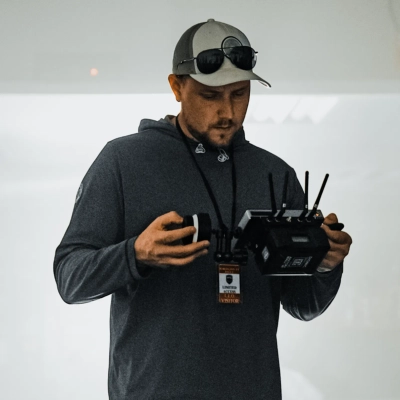How to Use Visuals in Advertising: 14 Tips for Impact
Visuals play a crucial role in the success of advertising campaigns, capturing attention and conveying messages effectively. This comprehensive guide offers expert insights on leveraging visuals to create impactful advertisements across various platforms. From strategic visual hierarchy to incorporating user-generated content, discover the key techniques that can elevate your advertising efforts.
- Guide Viewers Through Strategic Visual Hierarchy
- Align Visuals With Platform-Specific Behavior
- Reflect Brand Personality in Custom Graphics
- Leverage Human Element for Emotional Connection
- Build Recognition With Consistent Visual Language
- Use Creative Video to Elevate Brand Storytelling
- Address Viewer Hesitations Through Targeted Imagery
- Create Emotional Interruption With Powerful Visuals
- Design for the Scroll to Capture Attention
- Utilize White Space as a Strategic Design Element
- Compress Complex Messages Into Instant Understanding
- Sell the Feeling of the Outcome Visually
- Complement Ad Tone With Appropriate Imagery
- Incorporate User-Generated Content for Authenticity
Guide Viewers Through Strategic Visual Hierarchy
Visual hierarchy in advertising should guide viewers' eyes through your message in a strategic sequence that matches their decision-making process, starting with attention-grabbing elements and ending with clear action steps. Effective visuals create a narrative flow that makes complex offers feel simple and compelling while reinforcing your value proposition through design choices.
We redesigned display ads for a B2B software client by implementing a three-tier visual hierarchy: bold problem statement at the top, product benefit imagery in the middle, and prominent call-to-action button at the bottom. The previous ads scattered multiple messages across the creative without clear viewing patterns, resulting in confused prospects and poor click-through rates. Our structured approach increased ad engagement by 156% because viewers could quickly understand the problem, visualize the solution, and identify the next step without mental effort. One campaign targeting marketing directors used this hierarchy to communicate "Stop losing leads" - "Automated lead scoring" - "Start free trial" in a logical visual sequence.
Visuals enhance advertising messages by providing emotional context that text alone cannot deliver, helping prospects visualize themselves using your solution successfully. Color psychology, typography choices, and imagery style communicate brand personality while supporting your core message. Our most successful ads combine specific visual elements that reflect our target audience's work environment - clean office spaces, professional team interactions, and recognizable business tools - making prospects feel understood and represented. Visual consistency across campaign elements builds recognition and trust while supporting message clarity that drives conversion actions.

Align Visuals With Platform-Specific Behavior
One Key Tip: Design for Platform-Specific Audience Behavior & Context
True engagement starts by deeply understanding how your specific audience interacts with the platform where your ad will appear. Visuals must align with this context to enhance your message effectively.
How Visuals Enhance Your Message When Aligned with Platform Behavior:
Instant Comprehension & Stopping Power:
How: Use bold composition, contrasting colors, and immediate visual metaphors suited to the platform's scroll speed (e.g., ultra-simple for fast-scrolling Instagram feeds vs. slightly more detailed for Pinterest search).
Why it Works: Catches the eye within the first fraction of a second that users typically spend on a post, interrupting their habitual scroll pattern on that specific app. It makes your core message unmissable.
Emotional Resonance & Relevance:
How: Choose imagery, style (authentic UGC vs. polished studio), and cultural references that mirror the platform's dominant tone and your audience's expectations there (e.g., playful/casual for TikTok, aspirational for Instagram, professional for LinkedIn).
Why it Works: Feels native, not intrusive. Visuals processed 60,000x faster than text tap directly into emotions and shared context, making your message feel personally relevant and building an immediate connection.
Driving Action:
How: Incorporate clear visual cues (like arrows, directional gaze, prominent buttons) designed for the platform's common interaction patterns (e.g., swipe-up, tap, click). Ensure the "next step" is visually obvious within the expected user flow.
Why it Works: Reduces friction. Visuals guide the user intuitively towards the desired action, leveraging their existing muscle memory for that platform, making the message conversion-focused.
In essence: Don't just create a "good visual." Create a visual strategically crafted to fit where it will be seen and how your specific audience behaves in that exact space. This platform-behavior-first approach is what transforms a generic image into an engaging, message-enhancing, high-performing ad visual.

Reflect Brand Personality in Custom Graphics
One of the most effective ways to use visuals in advertising is to make them feel personal—like they were created just for your audience, by a business that understands them. Visuals should reflect the personality of your brand, not just its product or service. This means leaning into custom graphics, brand-specific color palettes, and real-world imagery that mirrors your values and tone of voice. Don't be afraid to be a little different or show that you march to the beat of your own drum. Diversity attracts attention, and it shows people you are not like everybody else. That's a good thing in advertising.
For example, a playful, approachable brand might use hand-drawn icons, bold fonts, and behind-the-scenes photos of their team. A more polished or high-end brand could use sleek animations, elegant design elements, and lifestyle photography that reflects their clientele. These aren't just aesthetic choices—they help build trust and connection.
Recently, one of our clients asked for honest feedback about his website, and we gave him the truthful answer: you could switch the name with five other MSPs, and it would be generic enough to encompass all of them. That client decided he wanted something that made his site stand out. He told us he liked graphics that had more of an animated vibe. He wanted to represent where he was from and show how he wanted to approach business with his customers. He gave us several documents that outlined his vision and theme, which reflected him, his mission, and his value proposition. We worked with him and made a site he was genuinely proud of because it showed who he was.
When your visuals reflect the true character of your business, they act like a handshake before the pitch. They tell your story at a glance, often before a single word is read. Stock photos and generic templates can't compete with that kind of authenticity. Authenticity and genuine engagement in your own brand build a natural sense of trust and kinship.
In short: great visuals don't just show what you do—they show who you are. That's what makes people stop scrolling, start engaging, and remember your brand when it counts.

Leverage Human Element for Emotional Connection
Effective use of visuals in advertising is a marketing home run for businesses of all sizes. Many people will look at the face value benefits like the perception and prestige quality visual content brings and stop there, but a deeper look will show something pretty amazing. Mediums like video, and to some extent photo, give us immense power over messaging and emotion. You're essentially packaging the "point" of your advertisement in a box, wrapped with the tone you want it delivered in.
There are so many ways to utilize visuals in advertising, but there's one thing in particular I'd like to discuss - the power and relatability of people.
People relate to other people. We can (and should) utilize this whenever possible because the human element speaks volumes to a viewer's emotional reception of the messaging in our advertisements. Let's go over an example.
A company that builds decks for residential homes will likely have images of beautiful decks that they've built in their advertising. Here are two ways we can incorporate a human element. First, showing the homeowners (or actors) in a lifestyle setting enjoying the use of their new deck. Second, showing employees doing the work in a setting where it's evident that they like what they do and really care about the finished product. Both of these incorporate people in advertising and are reassuring to the viewer.
Showing people and their emotions provides so much context for your messaging. This is captivating, reassuring, and motivating for our viewers. It also suggests social proof, meaning someone else has been your happy customer, which gives you some authority and credibility.
There are many ways to utilize visuals in our advertising, but one really effective way is to emphasize the human element. Think about the people you're providing value to and frame the way you want your customers to feel after working with you in your advertising. In most cases, it's really about them.
Build Recognition With Consistent Visual Language
One tip for effectively using visuals in advertising: Make sure they actually look like your brand. Don't just use pretty pictures, but choose images and design elements that feel unmistakably like the brand you've presented to the world. Your visuals should tell the exact same story your words do, so when someone sees your ad, your website, or even standalone photography while doomscrolling Instagram, they know exactly who they're looking at.
Visuals enhance your message by grabbing attention and setting the tone quickly. Most people decide how they feel about something within seconds, and nine times out of ten, it's based on what they see first. Strong visuals give your message personality and help it stick.
When you use that same visual language repeatedly, across platforms and campaigns, you start building something deeper: brand recognition. The goal isn't to be repetitive just for the sake of it, but to be consistent enough that your audience starts recognizing you without needing to read the name.

Use Creative Video to Elevate Brand Storytelling
When it comes to effective visual advertising, I've found that using creative video techniques can significantly elevate your brand storytelling. In our campaigns, we've utilized FPV drone footage to create dynamic perspectives that capture attention and immerse viewers in our narrative. This approach allows potential customers to experience your product or service from unique viewpoints that traditional filming simply cannot achieve. The key is ensuring these visual elements genuinely enhance your core message rather than distracting from it. Visual storytelling works best when it creates an emotional connection while simultaneously reinforcing your brand's key value propositions. Remember that compelling visuals should simplify complex ideas and make your message more memorable for your audience.

Address Viewer Hesitations Through Targeted Imagery
Great visuals don't just showcase your product; they silently address the viewer's biggest hesitation. For example, for an online education platform, that might be "I don't have time" or "Will this really work for someone like me?" Instead of showing a polished dashboard, use an image of a learner watching a lesson on their phone during a commute or late at night after putting kids to bed.
I've seen this shift in approach turn passive scrollers into sign-ups. Why? Because the image doesn't just inform; it reassures. It says, "Yes, this fits your life." A well-chosen visual can make your message believable before a single word is read.

Create Emotional Interruption With Powerful Visuals
Hi there,
Most businesses treat visuals like decoration. That's a huge mistake! The real power of imagery in advertising is emotional interruption.
We proved this with Just Bathrooms, a renovation brand stuck using generic "before-and-after" shots. We swapped those out for high-contrast, human-centered imagery that showcased why the change mattered. From parents bathing their kids safely to elderly clients navigating safer layouts.
This resulted in a 112% increase in conversion rate and a 53% drop in bounce rate within 60 days.
Visuals don't just support your message—they are the message. According to data from the U.S. National Library of Medicine, the human brain processes visuals 60,000 times faster than text. If your image doesn't tell a story or spark a feeling instantly, you've already lost them.

Design for the Scroll to Capture Attention
The best visuals don't just show your message; they amplify it. My go-to tip? Design for the scroll. You have half a second to earn attention, so your visual needs to instantly telegraph the core emotion or promise of your ad—without relying on text. A strong visual creates curiosity, clarity, or contrast that stops the thumb and starts the story. When done right, the image is the message, and the copy just seals the deal.
In case you end up using my input, here is my press kit with my bio, headshots, and backlink: https://thinkenvy.com/presskit

Utilize White Space as a Strategic Design Element
The best visuals are often no visuals at all, specifically, white space. Too often, clients perceive the white space I've intentionally included as empty real estate for more marketing content or branding elements. They might even provide the dreaded feedback, "make the logo bigger." However, that white space is what makes the existing visuals impactful and allows the design to actually function. White space isn't leftover area; it's as strategically designed as any headline or photograph. A skilled designer understands this and wields white space as deliberately as any other design element.

Compress Complex Messages Into Instant Understanding
I'm Jeff Mains, a five-time founder and CEO of Champion Leadership Group, where I help SaaS and professional service leaders scale with purpose and precision. Over the years, I've led companies past $200M in combined revenue and helped build brand systems that communicate clearly, especially through visuals.
For me, effective visuals in advertising compress complex messages into instant understanding. They skip the processing lag and tell the audience exactly what you do, who it's for, and why it matters (all before they read a word).
For example, when we were repositioning a software platform for mid-market clients, we redesigned the hero visual to show a chaotic multi-tab spreadsheet collapsing into one clean dashboard. It didn't need further complex explanation. Our clients instantly felt its promise of clarity and control. That shift alone boosted our conversion rate because the image did the heavy lifting before the headline even landed.
For me, the key is always this: does the visual do a job? If it reinforces emotion, simplifies complexity, or tells a story faster than words, it earns its place. Because remember, in advertising, every pixel should be pulling weight.

Sell the Feeling of the Outcome Visually
My one tip is to rigorously adhere to this rule: Sell the feeling of the outcome, not the features of the object.
Most businesses make the mistake of showcasing their product in isolation, focusing on what it is. This is a logical but emotionally sterile approach.
An effective visual bypasses logic and speaks directly to aspiration. It should almost never be a simple photo of your product/service/offer. Instead, it should be a powerful, emotional snapshot of your ideal customer's life after their problem has been solved by your offer.
This is how visuals enhance the message on a profound psychological level. When a prospect sees an image of someone who looks like them experiencing success, relief, or joy, they are not just seeing a product in use; they are seeing a blueprint for their own desired future. Their brain constructs a coherent story where your offer is the necessary catalyst for that transformation.
The visual stops being an advertisement for an object and becomes an irresistible preview of the person they aspire to be.

Complement Ad Tone With Appropriate Imagery
One of the finest ways to employ visuals in ads is to ensure they complement the tone and content of the ad. Good pictures do more than grab people's attention; they also support what you're saying. Your audience won't be able to connect with the emotional or cognitive appeal of your message if the image doesn't suit.
People can quickly connect with and get involved in high-quality photos or drawings that convey excitement, trust, or urgency. A good picture makes the text stand out and easier to understand.
It's also vital to keep things simple. People may not understand your message as well if your images are too intricate. Apple and Nike use simple, powerful pictures to get their point across without distraction.
Finally, be careful with how you use color and contrast. Psychology suggests that colors can influence emotions and behavior. Red creates a sense of urgency, whereas blue evokes feelings of security. This helps people remember and act on ads more effectively.

Incorporate User-Generated Content for Authenticity
One of the most overlooked yet powerful visuals in advertising is the user-generated kind—photos, short clips, or testimonials from real customers. They might lack polish, but they more than make up for it with credibility. People trust people. Seeing someone else use your product in a real-world context beats any studio shoot in terms of authenticity.
These visuals enhance your message because they humanize it. You're no longer a brand making a claim—you're a brand being validated by real people. That peer-to-peer feel turns passive viewers into engaged participants. And because this content is often raw and unscripted, it feels honest. In an era of hyper-curation, honesty is magnetic.



